Charles Dickens and the Dinosaur
Megalosaurus that opens Bleak House explored
By Herb Moskovitz
As presented to the Friends of Dickens New York City on September 10, 2011
Reprinted with the kind permission of the author
Published on this site June 3, 2015
"It would not be wonderful to meet a Megalosaurus, forty feet long or so, waddling like an elephantine lizard up Holborn Hill."
-- Bleak House
A while ago I was flipping the channels of my TV and saw a bit of a movie where a dinosaur was trampling through a modern city. I thought of a few other movies with similar scenes and wondered where did this image originate?
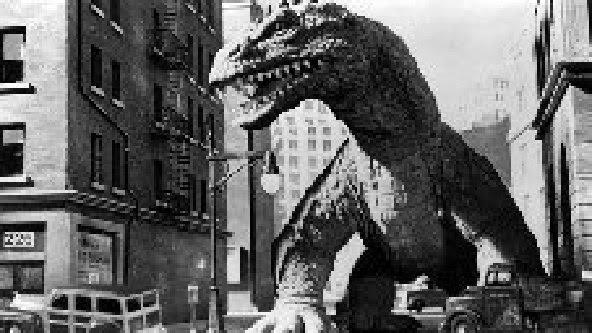
I thought first of the brontosaurus rampaging through London in the 1925 film, The Lost World. (In the book, Professor Challenger brings a baby pterodactyl back to London but it just flies away and doesn't interact with the modern city.)

The Lost World
Then I remembered the megalosaurus in Bleak House. So I called a friend of mine, Bob Walters, a well-known dinosaur illustrator and an expert on dinosaurs. He said the first image in literature of a dinosaur walking through a modern city was the megalosaurus in Bleak House. He thought it might be the first time a dinosaur is mentioned in literature, but Professor Michael Slater recently told me that a megalosaurus was mentioned in a short story in Dickens's journal, Household Words first. If anyone knows of an earlier example please tell me.
Dinosaurs were unknown until the first half of the nineteenth century. Up until then whenever a fossil was discovered it was assumed to be from some large version of a known animal that perished in Noah’s flood, or a dragon. In the early 1820s, the first dinosaur to be described in a scientific journal and named, Megalosaurus, was thought to be a huge lizard that walked on four legs. Megalosaurus is Greek for "big lizard." Bear in mind that all that was discovered of dinosaurs at this time were small fragments, perhaps a section of jaw and a few teeth and a piece of a femur.
After the discovery of Iguanodon and Hylaeosaurus, an early paleontologist, Richard Owen, realized they were all related and in 1842 coined a word to cover them all, "dinosaur" - (terrible lizard).
Britain got dinosaur mania. Newspapers and journals were filled with articles, paleontologists battled each other to discover bigger and better fossils and artists tried to envision what the fossils may have looked like with flesh.
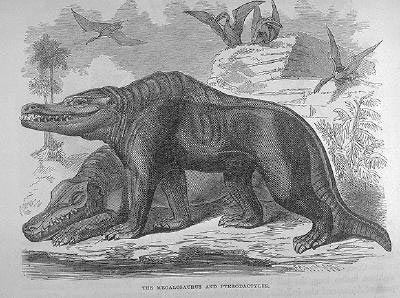
Megalosaurus as envisioned in the 1850s
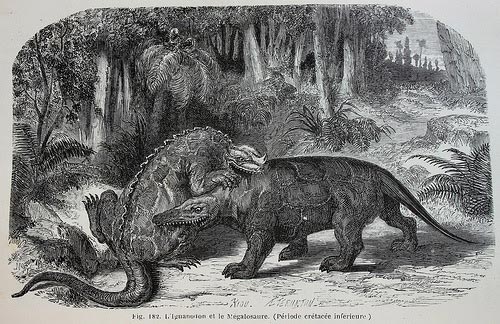
Early image of a Megalosaurus fighting an Iguanodon
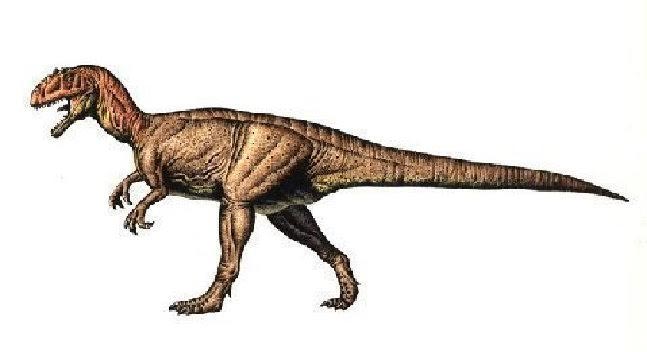
Megalosaurus as envisioned today - © Bob Walters
Dickens's journal Household Words published an article by Henry Morley, which included a reference to a megalosaurus in August 16, 1851. The article was called, "Our Phantom Ship on an Antediluvian Cruise."
A group of travelers meet "...a land reptile, before which we take the liberty of running. His teeth look too decidedly carnivorous. A sort of crocodile, thirty feet long, with a big body, mounted on high thick legs, is not likely to be friendly with our legs and bodies. Megalosaurus is his name, and, doubtless greedy is his nature."
Artist Benjamin Waterhouse Hawkins was commissioned in 1852 to create 33 concrete prehistoric animals for a sculpture garden outside of the Crystal Palace which was being relocated from Hyde Park to Sydenham in South London.
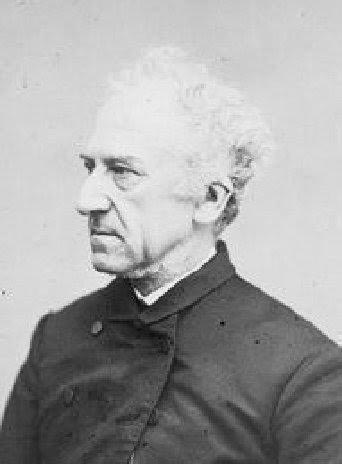
Benjamin Waterhouse Hawkins
He worked with Sir Richard Owen on what the animals may have looked like.
It has been suggested that Dickens saw the dinosaurs as they were being constructed and that it was the concrete megalosaurus that inspired him to include one while describing the primordial atmosphere of London in Bleak House.

Sydenham Studio
But Waterhouse (as he liked to be called) only got the commission at the beginning of 1852 and the first installment of Bleak House came out in March of 1852. The concrete dinosaurs weren't installed until 1854. But nevertheless Dickens would have seen two-dimensional renderings of what a megalosaurus may have looked like in the newspapers of the day.
In 1858 the first American dinosaur was discovered in southern New Jersey, just a few miles across the bridge from my home in Philadelphia. It was named Hadrosaurus and ten years later Waterhouse, working with paleontologist Joseph Leidy, assembled the world’s first dinosaur skeleton at the Academy of Natural Sciences in Philadelphia.

Waterhouse's Hadrosaurus in Philadelphia's Academy of Natural Sciences
The commissioners of the newly created Central Park in New York City asked Waterhouse to create a Paleozoic Museum. He set up a studio in the Arsenal in Central Park, at 5th Avenue and 64th Street.
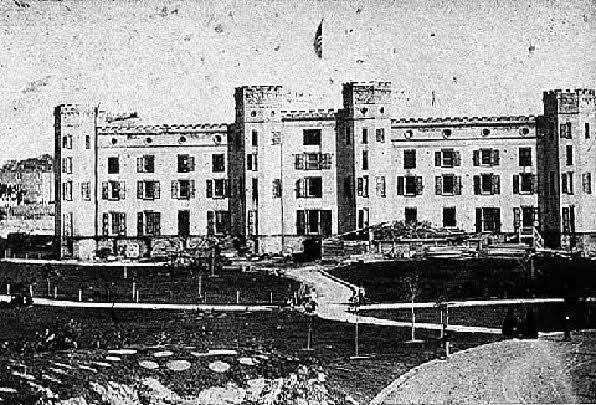
The Arsenal
The museum was to include sculptures similar to those in London, as well as many other exhibits. Seven of these were built.
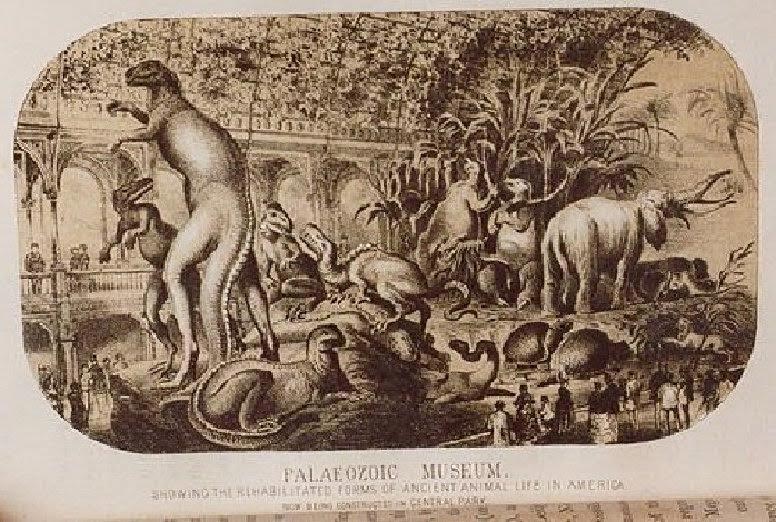
Planned Paleozoic Museum in Central Park

Studio inside the Armory
However Boss Tweed then got control of the park and stopped the construction. Waterhouse gave a speech at the New York Lyceum of Natural History (today called the New York Academy of Sciences) about the importance of science and art. But then he spoke out against Boss Tweed and the New York Times reported what he said. A short time later in 1871, Tweed’s thugs broke into the studio and using sledgehammers destroyed the models and their molds. The remnants were buried in the park where they remain today.
The Sydenham dinosaurs met a happier fate. They are still standing in lovely Crystal Palace Park where they can be seen by visitors every day.

Megalosaurus in Crystal Palace Park today
Photo: Herb Moskovitz
Sir Richard Owen was world famous in the 19th century and although he has been forgotten by the general public today, he is still revered by modern day paleontologists. And he has been immortalized by Dickens. In chapter two of Our Mutual Friend, when Dickens is observing the guests at the Veneering's dinner party, he describes Mrs Podsnap as a "fine woman for Professor Owen," with a "quantity of bone."
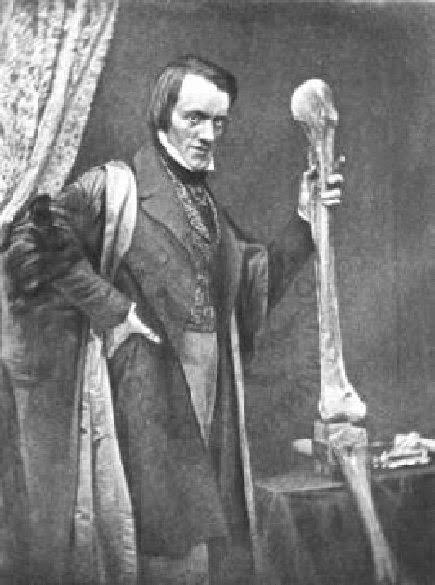
Sir Richard Owen
Thanks to Michael Slater for his superb suggestions, and to Bob Walters for his advice and permission to use his Megalosaurus illustration.
